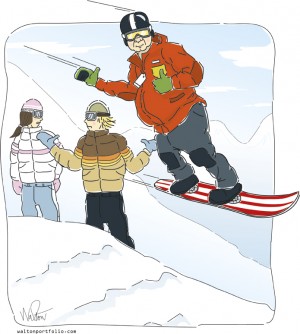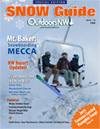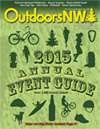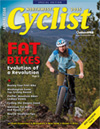Crave to Carve: Snowboarding is for Grown-ups, Too

By Peter Schroeder / Illustration by Jason Walton
Snowboarding is no longer the exclusive domain of the “yo, dude” grungsters with baggy pants and oversize parkas.
The roles have reversed in recent years with 30-, 40-, and 50-year-olds carving down the slopes on snowboards while their kids look on with resignation. Downhill adult skiers crossing over from two planks to one comprise the fastest growing market to embrace the sport followed by non-skiing young adults.
Compared with skiing, the learning curve for snowboarding is shorter. For those who ski, the changeover happens even quicker because the body stance for skiing can be readily transferred to a sliding style. However, adjusting to the terrain on a snowboard takes some getting used to.
When skiers choose a line down the slope or shoot across the flats, their thinking is automatic, but it takes some thought on a board because they’re basically moving sideways, not forward.
If, as an adult, you’re willing to sustain a few bruises your first days out — both on your bod and to your ego — here are some pointers to get you started.
Equipment
Snowboarding equipment consists of the board, bindings, and boots. Although any winter footwear could tie in with the soft binding, it’s best to select supple boots with good liners, such as Sorels, to soften the pressure of the front strap. Stiff boots and rigid bindings become an option after you reach intermediate ability.
For an optimum fit, select boots that almost feel small. After lacing the inner boot, flex forward: Your toe should slightly touch the front of the boot. After a week the boots will stretch and, if too large, can pack out and become sloppy in the heel.
Boards basically come in three styles: freestyle, all-mountain and racing. Beginners should opt for a freestyle board which is the most versatile and easiest to control. The length should come up between the chin and nose, although dimensions are not as critical as in skiing.
Equipment can be rented by the day or week at most ski area rental shops and specialty ski shops. Whereas beginning downhill skiers are advised to rent equipment their first season, this is not necessarily the case with snowboarding. Skiers need higher quality equipment as they progress, but the same snowboard can take a novice from beginner to an intermediate/ advanced level. With snowboarding, beginners can quickly master the fundamentals after a few days of practice and then move into higher performance maneuvers.
Clothing
Baggy and saggy — the typical snowboarder look — is for style, not function. Snowboard newcomers will do well to layer clothes, just like downhill skiers do.
Closest to the skin, wear long thermal underwear made of a wicking material to keep the body dry. Beneath a shell coat, layer a turtleneck shirt, sweater, and fleece vest or pullover. Insulated, loose-fitting shell pants allow for easy movement which is important considering you’ll be up and down a lot for the first few days.
(Tip: Add padding in the seat and knees to minimize aches and bruises from a lot of down time — as in “falling down” — as you ascend the learning curve. To counteract fatigue from standing on the board, you’ll be sitting on the snow much of the time and will appreciate having a cushier, insulating rear end to keep out the cold.)
Accessories
Although ski gloves will do the job, gauntlet gloves or mittens which extend to the elbow prevent snow from getting into the sleeves. Because a snowboarder’s hands constantly scrape the snow, gloves with durable exteriors are recommended.
Also, invest in some good double-lens orange or amber goggles.
Set aside part of your budget for two key safety items: a helmet and wrist guards. When you fall on a snowboard — unlike with skis — your board becomes an anchor, causing a sudden jolt to your body. Whereas skiing injuries typically involve the lower body, most snowboard injuries usually occur above the waist — shoulders, back, hips and, most frequently, the wrists. In case of a backward fall, the neck and head are most at risk.
Instruction
All resident and concession ski schools offer snowboarding instruction, and many provide packages for the beginner adult who may need a little more time and encouragement than kids to master the fundamentals.
If you think you’ll be self-conscious learning in front of the younger set, opt for an adult-only class. (Some instruction programs are designated women-only or men-only.) Snowboard schools are certified by the Professional Ski Instructors of America (PSIA), so you’re assured that teaching methods will be the same wherever you go.
Check out your nearby ski areas or contact a local snowboard school and find out where they take their students. If you join one of their programs, they may be able to arrange transportation and accommodations, saving you a few bucks with their quantity discounts.
Crave to Carve
Beginning snowboarders need only a smooth gradual slope for learning. After a few sessions you may want to head over to an entry-level terrain park and take on the challenges of smaller half-pipes, kickers, table tops, rails, and jumps. Before long you’ll hunger for those intermediate parks, Olympic-size half-pipes and beyond. Yo dude!



